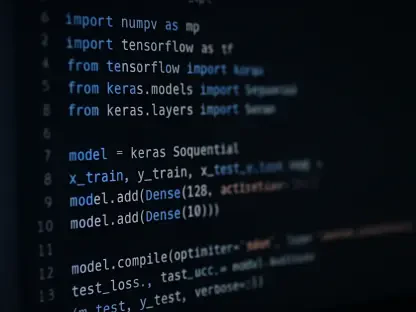I’m thrilled to sit down with Anand Naidu, our resident development expert, whose extensive knowledge in both frontend and backend technologies offers a unique perspective on the evolving world of programming languages. With a deep understanding of various coding paradigms, Anand is the perfect person to help us unpack the surprising resurgence of Perl in the Tiobe index, a key measure of programming language popularity. In this conversation, we dive into what’s fueling Perl’s comeback, the historical context of its versions, its competition with giants like Python, and what the future might hold for this veteran language.
Can you explain what the Tiobe index is and why it’s such an important benchmark for programming languages?
Absolutely. The Tiobe index is a widely recognized measure of programming language popularity. It’s been around for years and serves as a kind of pulse-check for the developer community. What makes it significant is that it aggregates data from multiple sources like search engine queries, online courses, and third-party vendor activity to rank languages. This gives a broad view of which languages are being talked about, learned, and used. For developers and companies, it’s a useful indicator of trends—whether a language is gaining traction or fading—and can influence decisions about what to learn or adopt for projects.
How does the Tiobe index specifically calculate a language’s popularity, and what sources does it draw from?
The Tiobe index looks at a variety of metrics to gauge popularity, primarily focusing on the volume of online activity around a language. It analyzes search results from engines like Google and Bing, checks mentions on platforms like Wikipedia, and even considers product listings on sites like Amazon, such as books about a language. The idea is to capture how much attention a language is getting from engineers, educators, and vendors. It’s not a perfect science, but it reflects real-world interest and engagement pretty well.
Perl has made a striking jump from 27th to 10th in the Tiobe index over the past year. What do you think is behind this unexpected resurgence?
It’s fascinating to see Perl climb back up the ranks after being somewhat sidelined for years. I think a big factor is the renewed clarity around Perl 5 as the definitive version of the language. For a long time, there was confusion with Perl 6, which took ages to develop and was eventually rebranded. That uncertainty pushed developers away. Now, with Perl 5 regaining focus as the ‘real’ Perl, it’s likely drawing back some of its old user base and even catching the eye of newer developers who value its strengths in text processing and scripting.
There’s a theory that the large number of Perl books on Amazon might be contributing to its high ranking. How much weight do you give to that idea?
It’s an interesting point. The sheer volume of books—apparently four times more than for languages like PHP—definitely boosts Perl’s visibility in the data Tiobe collects, since Amazon listings are part of their metrics. But I wouldn’t say it’s the core reason for the resurgence. It’s more of a symptom of Perl’s enduring legacy. Those books reflect a historical wealth of knowledge and a community that’s still out there, even if quieter. It might amplify the ranking, but the real driver is likely the renewed confidence in Perl 5.
Can you walk us through the history of Perl 5 and Perl 6, and how their development shaped the language’s journey?
Sure. Perl 5, released in 1994, became the backbone of the language and powered a lot of early web development and system administration tasks. It was hugely popular. But then, the idea for Perl 6 came along as a complete overhaul, promising modern features. The problem was, its development dragged on for decades, creating a split focus. Perl 5 updates slowed down, and the community didn’t know which version to bet on. Eventually, Perl 6 was rebranded as Raku in 2015 to separate it entirely. This long saga left Perl in limbo for years, but now Perl 5 is reclaiming its identity as the main version.
How did the prolonged uncertainty around Perl 6, and its rebranding to Raku, impact the Perl community?
The uncertainty was tough on the community. Developers thrive on stability and clear direction, and the Perl 6 delay—coupled with the split focus—created frustration. Many felt stuck waiting for a promised future that kept getting pushed back. Some stuck with Perl 5, but others drifted to alternatives that offered more certainty and active development. The rebranding to Raku helped by clarifying that Perl 5 wasn’t going anywhere, but by then, a lot of trust and momentum had been lost. It’s only now that we’re seeing a kind of reconciliation and renewed interest.
During Perl’s uncertain period, Python emerged as a strong alternative for many developers. What made Python so attractive at that time?
Python really stepped into the spotlight during Perl’s rocky years. It offered a clean, readable syntax that made it easy to learn and use, especially for beginners. It also had a growing ecosystem of libraries and frameworks, which made it versatile for everything from web development to data science. On top of that, Python’s community was active and welcoming, with consistent updates and clear direction. For Perl developers frustrated by version confusion, Python felt like a safe, modern bet with a lot of momentum.
Do you think Perl can win back some of those developers who switched to Python, and if so, what might draw them back?
It’s possible, but it won’t be easy. Perl still excels in specific niches like text manipulation and quick scripting, areas where it’s incredibly powerful and concise. If the community can highlight these strengths and modernize the language’s image—maybe through better tools or visibility in education—it could lure back developers who miss Perl’s unique capabilities. But Python’s dominance is hard to challenge. Perl would need to carve out a distinct space, perhaps in specialized industries, to regain that lost ground.
Looking at the current Tiobe rankings, Perl sits at 2.03% while Python dominates at 25.98%. How realistic is it for Perl to climb even higher in the rankings?
Honestly, climbing much higher will be a steep challenge. A jump to 10th is already impressive, but the top spots are held by languages like Python, Java, and C++ that have massive, entrenched user bases and broad application across industries. Perl’s 2.03% shows it has a dedicated following, but closing the gap to even 5% would require a significant shift—think major adoption in a trending field or a big push from influential tech communities. It’s not impossible, but it’s a long shot without a clear catalyst.
What are some of the biggest hurdles Perl faces in competing with top-tier languages, and are there specific areas where it could shine?
One major hurdle is perception. Perl is often seen as outdated or overly complex with its syntax, which can deter new developers. It also lacks the vast, modern ecosystem of libraries and frameworks that languages like Python offer. Then there’s the competition—languages at the top are backed by huge communities and corporate support. That said, Perl could shine in areas like system administration, bioinformatics, or legacy system maintenance where its text-processing prowess is unmatched. If it targets these niches and modernizes its tooling, it could grow a loyal user base.
The Pypl index, which measures popularity based on Google searches for tutorials, doesn’t rank Perl in the top 10, unlike Tiobe. Why do you think there’s such a discrepancy between these two rankings?
The difference comes down to what each index measures. Tiobe casts a wider net, looking at books, vendor activity, and general online presence, which might favor older languages like Perl with a long history of resources. Pypl, on the other hand, focuses purely on tutorial searches on Google, reflecting what people are actively trying to learn right now. Perl’s absence from Pypl’s top 10 suggests newer developers aren’t seeking it out as much, likely because it’s not seen as a ‘trendy’ language to pick up compared to Python or JavaScript. It’s more about current learning interest versus overall visibility.
What is your forecast for Perl’s future in the programming world over the next few years?
I think Perl will maintain a steady, niche presence rather than explode into mainstream popularity. Its recent Tiobe jump shows there’s still life in the language, especially with Perl 5 solidifying its position. I expect it to hold ground in specialized areas like text processing or legacy systems where it’s deeply ingrained. However, without a major push—say, adoption in a hot new field or a revitalized community effort—it’s unlikely to rival the top languages. My forecast is cautious optimism: Perl will stick around as a reliable tool for specific tasks, but it won’t dominate the broader landscape.









